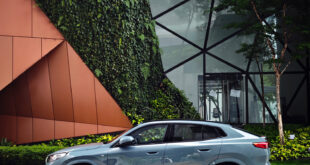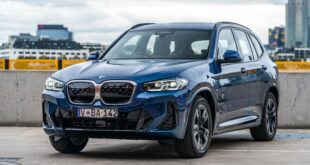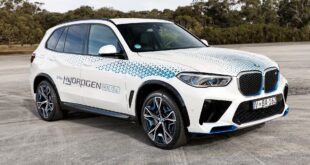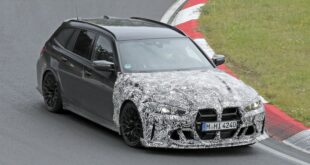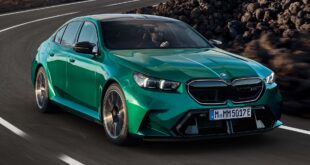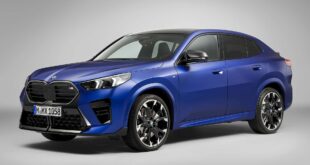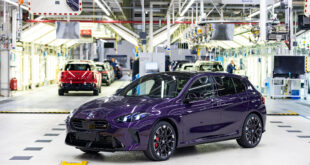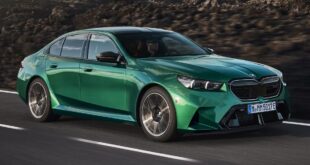 Singapore. A unique combination of driver assistance systems and mobility services has enabled the newly-launched BMW 7 Series to once again demonstrate its innovative edge and technical eminence over its rivals and enabled the opulent flagship BMW limousine to maintain its leadership position in the luxury segment.
Singapore. A unique combination of driver assistance systems and mobility services has enabled the newly-launched BMW 7 Series to once again demonstrate its innovative edge and technical eminence over its rivals and enabled the opulent flagship BMW limousine to maintain its leadership position in the luxury segment.
BMW ConnectedDrive is an intelligent link-up between driver, car and the outside world that maximizes in-vehicle convenience, infotainment and safety via an extensive portfolio of technology features.
“BMW ConnectedDrive reflects the philosophy of integration of the vehicle, driver and environment in an intelligent network. Through intelligent interaction between online services, driver assistance systems, call centre services and integration solution for smartphones support, Connected Drive plays a pivotal role in providing BMW drivers with more comfort, the right information at the right time, as well as that reassuring feel of being safe while on the roads,†said Mr Neil Fiorentinos, Managing Director of BMW Group Asia.
Some of the new Connected Drive features that are making their debut in the new BMW 7 Series, include; Anti-dazzle High-Beam Assistant that can partially dim to avoid dazzling the oncoming vehicle; and Driving Assistant Plus which will intervene by decelerating the vehicle or even pulling the brakes to avoid a collision; Park Assistant that facilitates parallel parking alongside the road; contactless bootlid opening system that opens the tailgate with a leg-movement sensor while the driver’s hands are full; just to name a few.
New-generation Navigation System Professional: display and control in the third dimension.
The latest-generation Navigation system Professional is compelling at first glance for its revised design and honed operating system. The tried-and tested menu navigation has been consciously retained and augmented by further functions. The user interface has benefited from a complete graphic revision and now comprises 3D elements throughout, while the entire architecture of the individual menus is now presented in virtual, three dimensional spaces. Thanks to its 1.3 GHz processor and dedicated 3D graphics card, using the system with its high-quality animations and dynamic transitions is an experience, supported by imagery boasting unprecedented levels of contrast and brilliance.
The PIE menu: greater operating convenience at a click.
The interactive map view also comes with the option of selecting special functions directly from the map: using the iDrive Controller, the driver can mark a spot in the interactive map to open the PIE menu. This radial menu offers quick and easy access to a host of options. Depending on the information stored, the driver can have POIs in the area flagged up, read up on any stored details, start navigation to any of the points, alter the map view and have the current location or destination displayed. If further information on a POI – e.g. telephone number, online data or email address – is also stored, the driver can instantly access these and make a call, visit the homepage or compose an email.
Split-screen display with more detailed guidance views.
The split screen in the central information display likewise comes with added functions. To facilitate the driver’s orientation while entering the destination by selecting the country, city and road, the chosen location is additionally displayed in the map view on the split screen. If required, the zoom function can be used to verify whether the destination shown in the relevant section of the map is the intended one.
For the navigation process itself, the familiar low-level guidance via arrows in the split screen has now been joined by a high-level guidance variant. This is automatically activated when the driver reaches a certain point ahead of the next navigation instruction. From a specified distance, which varies according to the category of road, the arrow display turns into a schematic, perspective view of the surroundings, offering the driver even better orientation thanks to its enhanced depiction of the location and precise lane guiding. For an optimal picture, the perspective view changes in stages to a top view of the junction or intersection as the vehicle approaches it, while a dynamic vehicle indicator pinpoints the car’s current position.
Then there is the 3D city model option that offers an impressive view to aid navigation. If the relevant representation of the city is stored in the car, a highly realistic depiction of the surrounding streets and houses makes it easier for the driver to find his way around.
The multifunctional instrument cluster display.
In place of the classic instrument cluster in which four circular analogue dials inform the driver of speed, rpm, tank level and oil temperature, the new BMW 7 Series now offers, for the first time, a multifunctional instrument display. The basic layout with four circular dials is retained, while a virtually invisible 10.25-inch integrated screen provides an entirely novel and engaging display experience that deliberately evokes modern electronic devices. It allows the driving experience modes COMFORT, SPORT and *ECO PRO to be individually shown, for example. In addition to colour differentiation, the information content of the instruments is also varied according to the driving mode selected, thus presenting the driver with a display that is optimally adapted to the situation at hand.
(*ECO PRO mode is not available for the BMW 760i / Li.)
BMW Night Vision.
At the heart of the Night Vision system is an infrared thermal imaging camera integrated into the BMW kidney grille. This provides a live video image which clearly highlights any objects giving off heat, despite being far beyond the range of the high beam. The system recognises pedestrians, cyclists and animals in plenty of time, even when they are outside the headlights’ beam of light. The automatic pedestrian recognition control unit then analyses the image to determine whether the vehicle is on a collision course with any pedestrians or cyclists. If a person at the roadside is deemed to be potentially at risk, a high-resolution icon will flash up in the central Control Display or the BMW Head-Up Display as a warning.
Anti-dazzle High-Beam Assistant with intelligent control.
The BMW 7 Series is now available with Adaptive LED Headlights which provide a further safety boost when driving at night. The bright white light they emit illuminates the road ahead with an exceptional intensity. Together with the High-Beam Assistant, the Adaptive LED Headlights with cornering lights as well as variable headlight distribution, they continue to represent the ultimate in lighting technology. The anti-dazzle High-Beam Assistant in conjunction with Adaptive LED headlights ensures that the driver can enjoy optimal visibility at all times without having to switch manually between high and low beam. The system uses a camera integrated into the rear-view mirror to identify vehicles travelling up to 400 metres in front. Oncoming traffic is picked up when it is still 1,000 metres away. With the High-Beam Assistant activated, the headlights are partially masked as and when required in order to eliminate the danger of dazzling vehicles as they draw closer. If necessary, however, the High-Beam Assistant can also adapt to the traffic situation by switching to low beam on one or both sides.
Driving Assistant Plus brakes to a halt if required.
The Active Cruise Control system Driving Assistant Plus builds on the familiar cruise control system with Stop & Go function (ACC with Stop&Go). For an enhanced interpretation of the traffic situation ahead, the full-range radar sensors are now supplemented by a front-mounted camera on the rear-view mirror. When driving in heavy-flowing traffic or traffic jams, the driver is able to safely move along with the flow and let the vehicle’s automatic systems handle the tasks of stopping and pulling away again as well as approaching junctions where there are already vehicles waiting ahead. Combining radar and video data in this way improves detection of other vehicles and cuts the system’s reaction time. If a vehicle ahead brakes very sharply in free-flowing traffic, requiring the driver to take action, he is prompted to do so by a two stage warning. Simultaneously to this, the activation thresholds of the Brake Assist system are lowered, activating the brake priming function in the process. If the driver fails to react to the acute warning, Driving Assistant Plus will intervene to decelerate the vehicle itself, even braking it to a stop depending on the situation. With Driving Assistant Plus, the upper limit of the operating range for the Active Cruise Control with automatic distance control has now been increased by 30 km/h, meaning it is available at speeds between 30 km/h and 210 km/h. The intelligent cruise control function continues to be active at speeds above 210 km/h.
Active Protection monitors the driver’s behaviour at the wheel.
The BMW 7 Series now boasts an even more extensive Active Protection safety package thanks to the addition of the Attentiveness assistant. The system’s electronics analyse driving behaviour on the basis of various signals such as steering angle, road speed and other engine parameters. If the system increasingly detects telltale signs of fatigue starting to build up, the central Control Display encourages the driver to take a break by displaying a coffee cup symbol. At the start of every journey when the driver and front passenger fasten their seat belts, the Active Protection motorised belt retractors reduce any belt slack. If the car enters a critical pre-crash scenario, the driver and front passenger belts are pulled tight, and the side windows and sunroof are closed. Active Protection deduces that a collision is likely based on data from the front-mounted camera or radar, an emergency braking manoeuvre initiated by the driver, or the onset of heavy understeer or oversteer. If a crash is unavoidable, the system will automatically brake the car afterwards without any intervention required from the driver. Following the initial impact, the car is slowed to a standstill with a maximum deceleration rate of 5 m/s² and its brakes then locked for a further 1.5 seconds. This reduces the likelihood of – or even prevents – a secondary collision.
Speed Limit Info with No Passing Info display using road sign symbols.
In combination with the Professional or Business navigation system, an optional Speed Limit Info is available to keep the driver notified of the detected speed limit for the current stretch of road. The front-mounted camera integrated into the rear-view mirror continuously monitors road signs, including variable-message overhead signs on motorways and dual carriageways. This information is checked against the navigation system’s database of speed limits. The camera is also able to take into account additional signs or temporary restrictions, for example at roadworks. As with speed limits, a No Passing Info display can now also be flashed up in the instrument cluster or BMW Head-Up Display in the form of a road sign until the restriction has been lifted. Furthermore, drivers now have the benefit of a Speed Limit Device, which caps the car’s maximum speed at between 30 and 230 km/h, as set by the driver.
Yet more unrivalled driver assistance systems and mobility services.
Apart from the highlights detailed above, BMW ConnectedDrive in the BMW 7 Series encompasses a host of sophisticated features and technologies designed to delight anyone seeking supreme convenience, infotainment and safety.
These include the existing full-colour BMW Head-Up Display, the rear view camera and Surround View, Parking Assistant, and contactless bootlid opening system.
Source: BMW Asia
 BMW.SG | BMW Singapore Owners Community The Ultimate BMW Community – Established Since 2001
BMW.SG | BMW Singapore Owners Community The Ultimate BMW Community – Established Since 2001

